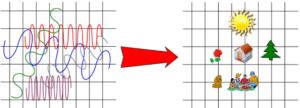quantum realm - Quantum Physics Lady (original) (raw)
A number of interpretations of quantum mechanics postulate a “quantum realm.” These include the Transactional Interpretation. One of its developers, Dr. Ruth Kastner, calls it “Quantumland.” But many interpretations, the Copenhagen Interpretation among them, do not postulate a quantum realm.
Below is a drawing of the quantum realm that Dr. David Chalmers, the noted philosopher of physics, presented in speaking about this issue. Note that in speaking about the quantum realm, Chalmers does not necessarily endorse the idea.

The quantum realm on the left underlies our everyday world on the right. [Image source: David Chalmers and Kelvin McQueen, “Consciousness and the Collapse of the Wave Function” (modified to remove a technical term). http://consc.net/slides/collapse.pdf]
In this drawing, the waviness on the left is a metaphor for the quantum realm. It is a metaphor rather than realistic. This is because the transformation from the quantum realm to the macroscopic realm is generally considered to occur at the subatomic particle level rather than at the macroscopic level of tables and chairs (and picnic blankets).
Classical wave traveling through a mesh. This is not a quantum wave because it is rippling through a medium made of matter. Matter is formed from quantum waves; it is not the medium through which quantum waves ripple. _[Animation by: Christophe Dang Ngoc Chan (cdang) – Own work, CC BY-SA 3.0;_ https://en.wikipedia.org/wiki/Se… ]
The weirdness of quantum mechanics is due to the interaction of the quantum realm with the macroscopic realm. Specifically, the weirdness arises because the quantum realm operates according to different laws than those of the macroscopic realm. Here are some of the key differences as seen in some interpretations of quantum mechanics:
- In the quantum realm, matter and energy manifest wavelike behavior. These waves are distinct in their mathematical descriptions from the waves of the macroscopic realm.
- In the quantum realm, matter and energy do not have definite properties at any particular moment of time. They have a range of possible properties. Each property has a probability of manifesting in the macroscopic realm upon interaction. For example, in the quantum realm, an electron has a certain probability of having spin up and a certain probability of having spin down. Upon measurement (a type of interaction) the electron might be found to have a definite property, let’s say, spin up. But the mathematical description of the electron when in the quantum realm (Shrodinger’s Equation) ascribes merely probabilities to spin up and spin down.
- The Heisenberg Uncertainty Principle arises from the quantum realm.
- Entanglement and quantum tunneling both arise from the quantum realm.
- The ability of particles to, apparently, change the past, as in the Delayed Choice Double Slit Experiment, arises from the quantum realm.
Living in “The Matrix”
One theory of the quantum realm is that it underlies our physical reality similarly to the way that computer code underlies what we see on our computer monitor. This is a metaphor, for example, which appears in the Transactional Interpretation of quantum mechanics. It’s also an implication of the idea that we live in a virtual reality. This idea is garnering increasing interest among physicists and philosophers such as Nick Bostrom (philosopher of science) and Nobel Laureate George Smoot (physicist).
In a computer, code is a sea of ever-changing numbers as electricity zips through the computer wiring and changes the states of electrons. But the ever-changing numbers of code are meaningless to most of us. For our convenience, the changing numbers of the code light up pixels on the screen. The pixels create images and text on the screen, allowing us to grasp the meaning of the underlying computer code.
The coding of virtual reality as in “The Matrix.” _[Image source: By Jahobr – Own work, CC0,_ File:Digital rain animation medium letters shine.gif]
In this view, our everyday reality is something like the virtual reality world of “The Matrix,” which most humans mistook for reality. All the while, their bodies were kept alive in vats, and their brains were hooked up to computers. They saw a virtual reality world created by code; and we see a macroscopic world created by the quantum realm.
This view does not require that we live in a virtual reality produced by a computer. It could, for example, be a virtual reality created in consciousness. This idea is at least as old as Buddhism but has been gaining new currency, as in the work of Dr. Donald Hoffman (see video below).